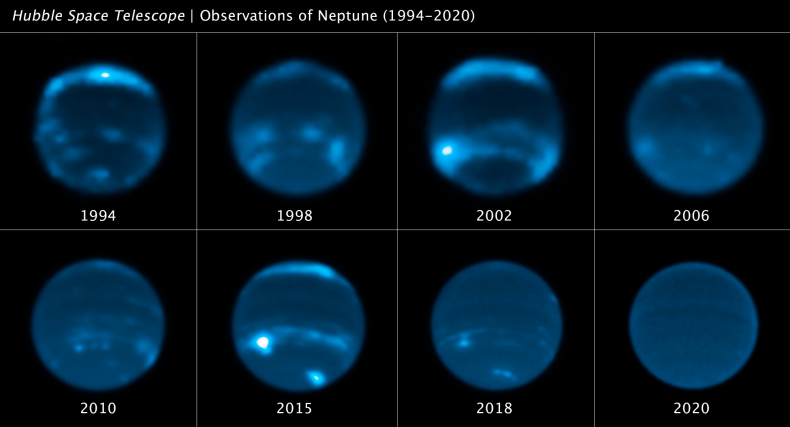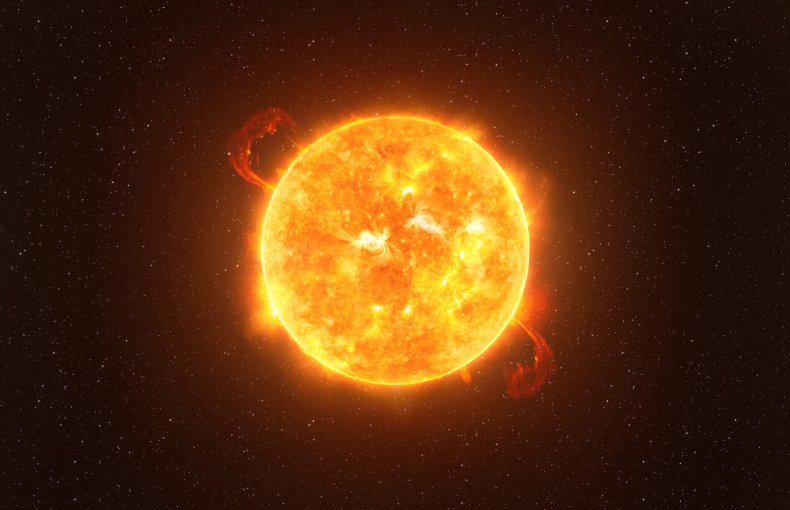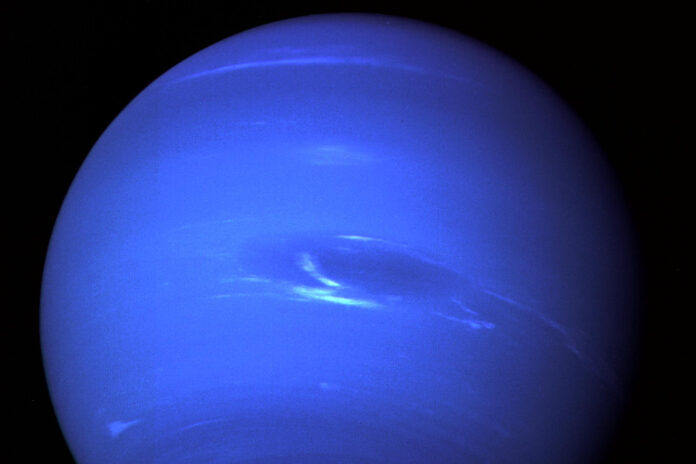The pale wisps of clouds that usually streak across Neptune’s skies have disappeared over the past couple of years, leaving the planet mysteriously naked.
Scientists mystified by this disappearance have noticed that the number of clouds on the distant planet is correlated to the 11-year solar cycle of our sun’s activity.
The more active the sun is, or the closer it is to its solar maximum, the more clouds appear to be present in Neptune’s atmosphere, with the opposite being seen during the solar minimum, a new study published in the journal Icarus shows.
NASA/JPL
The solar cycle is a cycle of the sun’s activity, increasing towards the solar maximum and decreasing towards the minimum around 6 or 7 years later. At the maximum, the sun’s magnetic field flips, leading to an influx of solar flares and coronal mass ejections. The last solar minimum was in 2019, and the next maximum is forecast for 2025.
Hubble Space Telescope imagery from 1994 shows that this pattern of cloud behavior on Neptune has happened before, following the solar cycle.
This is a strange finding, considering how far away Neptune is. Neptune, named after the Roman god of the ocean, is the eighth planet in our solar system, and is the fourth largest of the gas giants, after Jupiter, Saturn and Uranus. Neptune is around 2.8 billion miles from the sun, around 30 times more distant than the Earth.

NASA, ESA, LASP, Erandi Chavez UC Berkeley), Imke de Pater (UC Berkeley
Due to its immense distance from the sun, Neptune receives a minuscule fraction—1/900th—of the solar radiation that the Earth does.
The researchers noticed the cloud levels on Neptune rapidly dropping during 2019, leading them to look back at observations of the planet across the past few decades.
“I was surprised by how quickly clouds disappeared on Neptune,” Imke de Pater, emeritus professor of astronomy at UC Berkeley and senior author of the study, said in a statement. “We essentially saw cloud activity drop within a few months.”
They found that the planet appeared brighter when it had more clouds in its atmosphere and that this brightness increased in 2002, dimmed in 2007, became bright again in 2015, then dimmed once more in 2019 and 2020.

NASA, ESA, Erandi Chavez UC Berkeley), Imke de Pater (UC Berkeley
“Even four years later, the images we took this past June showed the clouds haven’t returned to their former levels,” Erandi Chavez, a graduate student at Harvard University’s Center for Astrophysics who led the study when she was an undergraduate astronomy student at UC Berkeley, said in the statement. “This is extremely exciting and unexpected, especially since Neptune’s previous period of low cloud activity was not nearly as dramatic and prolonged.”
As the sun gets more active as it builds up to its maximum, it begins to emit more powerful and intense ultraviolet (UV) light. The study found that around two years after this UV emission begins, Neptune’s clouds begin to appear, indicating that this UV is perhaps responsible for cloud formation.
“These remarkable data give us the strongest evidence yet that Neptune’s cloud cover correlates with the Sun’s cycle,” said de Pater. “Our findings support the theory that the Sun’s UV rays, when strong enough, may be triggering a photochemical reaction that produces Neptune’s clouds.”

ISTOCK / GETTY IMAGES PLUS
As the sun heads toward the 2025 maximum, Neptune too appears to be amping up its cloud cover in response.
“We have seen more clouds in the most recent images, in particular at northern latitudes and at high altitudes, as expected from the observed increase in the solar UV flux over the past 2 years,” de Pater says.
More research needs to be done into the exact mechanisms of cloud formation on the gas giant, however, as there may be a number of other factors at play within the planet’s deep atmosphere.
“It’s fascinating to be able to use telescopes on Earth to study the climate of a world more than 2.5 billion miles away from us,” Carlos Alvarez, staff astronomer at Keck Observatory and co-author of the study, said in the statement.
“Advances in technology as well as our Twilight Observing Program have enabled us to constrain Neptune’s atmospheric models, which are key to understanding the correlation between the ice giant’s climate and the solar cycle.”
Do you have a tip on a science story that Newsweek should be covering? Do you have a question about the solar cycle? Let us know via [email protected].


